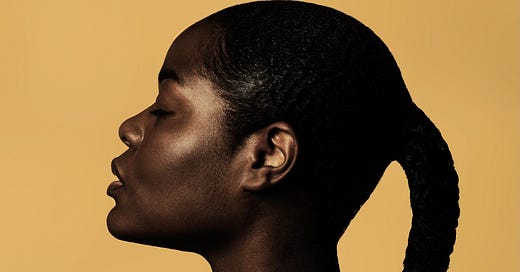4 Powerful Ways I Found Self-Worth Between Two Cultures (And How You Can Too)
Between stimulus and response there is a space. In that space is our power to choose our response. In our response lies our growth and our freedom." - Viktor E. Frankl
Hello and welcome to the Self-Worth Journal, I am Sheila Daisy a daughter of two cultures and a Self-worth and Self Acceptance advocate. I write about my personal experiences with both of these concepts and how I have been able to build and nurture my self-worth. I hope that you will not only enjoy but find real value in my writing. Enjoy!
Growing up between two worlds wasn't something I understood as unique or special. It was simply my reality—a constant dance between languages, traditions, expectations, and identities. Only as an adult did I come to appreciate that this cultural duality wasn't just a challenge to overcome, but a profound gift that shaped who I am.
The Invisible Tug-of-War
There were days when I felt like a walking contradiction. At home, one culture demanded respect for its traditions, its language, and its way of being. Step outside, and another set of expectations awaited. Who was I supposed to be? The obedient child honouring ancestral customs, or the independent individual embracing contemporary values?
This silent struggle intensified when I met an ex-partner who even though also hailed from the birth land, expected me to have and walk around with long flowing hair like a Caucasian. I know this is trivial but for me it wasn’t because being brought up in a country where you always looked different in rooms 98% of the time had me wanting to look like everyone else but there was this part of me that felt neglected.
So, meeting a man from the same country I was born whom I thought I’d spend my life with was refreshing but that couldn’t be farther from the truth. As he was more interested in neglecting our roots than in finding a balance of the two. How am I supposed to honour them with the respect they felt entitled to whilst pretending to be someone else? I often felt like an impostor in both worlds—not "authentic" enough for one culture, too "foreign" for the other.
Social gatherings became exercises in code-switching, changing not just my language but my entire persona depending on who surrounded me. It felt exhausting but as time went on I stopped associating with my fellow Africans because I couldn’t seem to get it right with them.
My whole perspective has been to take the good from both cultures and marry them to suit me but that made me a sell-out to some. I was tired of switching who I was all the time to please others and so I stopped hanging out with them.
Research shows I wasn't alone in this experience. Studies on bicultural identity integration reveal that many individuals from dual cultural backgrounds experience what psychologists call "cultural frame switching"—the unconscious shifting between different cultural interpretations and behaviours based on contextual cues.
According to work by researchers Benet-Martínez and Haritatos, this experience can either become a source of internal conflict or a foundation for psychological flexibility. For me, it was the former, before I knew and accepted who I really am.
The Breaking Point
My moment of clarity came during the lowest period in my adult life. By now I was in my thirties and had just gotten out of a toxic relationship. I thought it was my ex - the African who had some identity issues but my latest ex a white British was no better.
Both didn’t want me to wear my natural afro nor wear braids. They both had this idea of how a woman living here in the western part of the world should look like. But I couldn’t blame them more than I could blame myself, I was the common denominator here. Exhausted from trying to be two different people, I had a conversation with my coach and she asked me a simple question:
“Why do you feel the need to be someone different to please people?”
I didn't have an answer to that. I went away from our session in deep thought. That evening I sat down with my journal and asked myself that same question, I poured my heart out on the paper with everything that could come to mind. But the conclusion was I didn’t know and accept myself exactly as I was and that was the root of the identity conflict. In our next session, I explained what I had found and she asked -
“What if your identity isn't about choosing between cultures but creating something entirely new from both?”
That question was what started my journey of self-discovery that fundamentally transformed my relationship with my dual heritage. I began to see that being my authentic self wasn't about perfectly embodying either culture, but about honouring how both had shaped my unique perspective.
Finding My Self-Worth in Cultural Synthesis
My journey to self-acceptance wasn't straightforward, but several practices helped me embrace my cross-cultural identity:
1. Curiosity Instead of Judgment
I began approaching both cultures with a renewed curiosity. Instead of feeling burdened by cultural expectations, I asked: "What values from each culture resonate with me personally?" This shift from obligation to exploration allowed me to engage with traditions from both cultures more authentically.
2. Finding My Cultural Anchors
After identifying specific elements from each culture that felt genuinely meaningful to me, these became my cultural anchors, grounding me while allowing room to be —be it certain family traditions, values, foods, music, and stories that resonated on a personal level.
3. Reframing Duality as Strength
My search brought me new knowledge rather than feeling torn between two identities I began to embrace this as a strength, research on multicultural individuals by psychologist Carmit Tadmor reveals something powerful: those who successfully integrate multiple cultural identities often demonstrate greater creative thinking, professional success, and empathy.
I began to see my dual perspective not as a source of confusion but as a competitive advantage—a way of seeing the world through multiple lenses that many others without these firsthand experiences cannot.
4. Practicing Self-Compassion
One important thing I took away from my coaching and that has been another anchor throughout my journey is being compassionate with myself. Perhaps most importantly, I learned to be gentle with myself during cultural "mistakes" or when feeling caught between worlds. Research by Dr. Kristin Neff shows that self-compassion—treating yourself with the same kindness you would offer a good friend—significantly improves psychological well-being and resilience.
I cannot stress the power of positive self-talk enough, the emotional rollercoaster of going through this was not fun so I let my own inner cheerleader be louder than any other voice I was listening to.
It took a while but I realised if I was going to be able to live stress-free and authentically I had to accept more than just my looks but also the personality the two cultures had helped me build.
The Gift of Cultural Complexity
Today, I no longer see myself as half one thing and half another, somehow less than whole in both worlds. Instead, I am more than the sum of my cultural parts—I am the unique synthesis that could only have emerged from this specific intersection of heritages, experiences, and choices.
My self-worth now comes from embracing this complexity rather than fighting against it. I've learned that authenticity isn't about my cultural purity but about honouring the beautiful, messy and chaotic truth of my multicultural life.
Your Turn With Further Resources
I was surprised to find how much work is out there to support so here are further resources for anyone who like me might be staying on the cultural bridge walk or know someone who is.
The Person You Mean to Be by Dolly Chugh – Offers insights on embracing identity complexity and dealing with unconscious biases
Third Culture Kids: Growing Up Among Worlds by David C. Pollock and Ruth E. Van Reken – A foundational resource for understanding the experience of growing up amid cultural complexity
Online communities like Mixed Remixed – Platforms where people share experiences and strategies for navigating multicultural identities
Mindfulness practices – Research shows these can help manage the stress of cultural identity negotiation while building self-acceptance
My Final Thoughts
My journey to self-worth as a cultural bridge-walker hasn’t always been easy, but it has led to a rich and nuanced understanding of both myself and the increasingly interconnected world around me.
I have found that the very complexity that once felt like a burden becomes our greatest strength—a gift that allows us to connect across boundaries, see beyond single perspectives, and create a uniquely authentic life that honours all parts of who we are.
My biggest takeaway is remembering that I don't have to choose. I don't have to be less of one thing to be more of another. My worth lies precisely in that beautiful space between worlds where something entirely new—entirely me—has emerged.
Thank you for reading, I would love to hear your thoughts, perspectives and experiences so please do share them in the comments. If you know someone who might resonate please do share this with them.
Wishing you a beautiful week ahead.
Love & light
Sheila Daisy






Amazing and inspiring Sheila. Thank you for sharing your story ❤️🫶🏻
Your journey of self discovery is truly inspiring , i surely learnt something new , sending you all the love ❤️